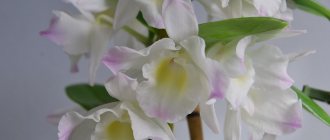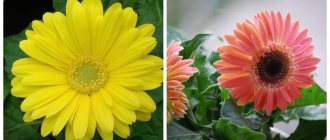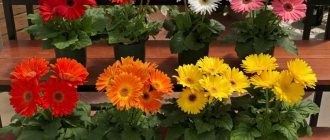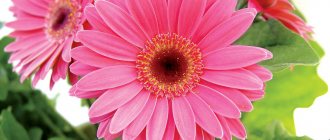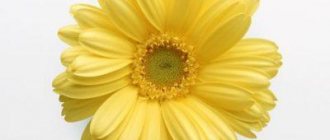If you imagine a flower arrangement in the form of a small instrumental orchestra, then with its expression and extravagance the gerbera, without a doubt, will ideally cope with the role of its first violin. It is not for nothing that florists, when creating bouquets and designers for decorating gardens, give it their preference: the dominant brightness of colors and elegant laconicism of forms are the explanation. However, the work of breeders has today allowed amateur flower growers to decorate their window sills with one of the most attractive types of flowers called Jameson's gerbera, the cultivation of which from seeds has become available indoors.
This plant belongs to the Asteraceae family. The Transvaal province in South Africa is where the Gerbera Jameson was first discovered by Europeans. Hence the second name of the wonderful flower - “Transvaal chamomile”. It was she, as a type of gerbera, that laid the foundation for many hybrid varieties cultivated indoors. On the shelves of flower shops you can often find a representative of this dwarf species in cut form as part of bouquets.
Gerbera Jameson is a herbaceous perennial. It has been grown for many years as an ornamental flowering potted plant. It has a thick stem and deeply divided juicy green leaves, collected in a basal rosette located just above the ground surface. The leaf length is from 15 to 20 cm, the surface can be smooth or pubescent. There may be cases of axillary buds forming at the base of the leaf.
In cultivation, the indoor species is represented by several hybrid varieties. Among them, the most popular is the Gerbera Jameson revolution, the photo of which did not leave indifferent the vast majority of flower growers - professionals and amateurs. The variety belongs to the ultra-early line of potted gerberas with large flowers and a dozen shades. The height of the Jemson revolution gerbera is only 10-15 centimeters, and you can admire the first inflorescences from the moment of emergence after just over 4 months.
Both double and non-double, as well as needle-shaped forms with inflorescences in the form of baskets, which are mistakenly called flowers, are cultivated. The inflorescences have amazing colors of the edge petals of a whole palette of colors: white, pink, yellow, orange, red and even red-black, collected around a yellow center. The inflorescence resembles a daisy with a diameter of approximately 10 cm, formed in the upper part of a powerful peduncle reaching 30 cm.
After the first acquaintance, it’s time to reveal the secrets of success in cultivating Jameson’s gerbera in indoor floriculture in Russia.
Planting/growing
To achieve the desired result from growing indoor gerberas - abundant, long-lasting and bright flowering - you will need to create favorable conditions and make a sufficient amount of effort. It is necessary to choose the brightest window and provide a curtain that will help protect the flower from the scorching rays of the sun. By creating optimal light and temperature conditions, providing “tasty” soil and proper watering, you can enjoy all the beauty of a blooming South African curiosity.
Transfer
Florists advise not to rush into replanting your home gerbera soon after purchasing it. Every plant needs some period of time to adapt to new living conditions, and our flower is no exception. Replanting once a year, preferably in February, is quite acceptable in order to place the plant in a larger pot using the transfer method. The bottom of the vessel should be filled with a generous layer of drainage. Experienced flower growers chose a special pot for gerberas with a hole at the bottom for external watering. This allows you to avoid stagnation of moisture at the surface of the roots, which is detrimental to the root system.
Different plants prefer their own soil for planting, and Jameson's gerbera will be content with light, but at the same time nutritious soil. You can buy ready-made soil for roses in the store, since these flowers have similar soil requirements. If you decide to prepare the mixture with your own hands, then a recipe will do, containing equal parts of leaf and peat-containing soil, as well as coarse sand. It wouldn't hurt to add hydrogel, or at least pine bark. When planting, it is important not to bury the leaf rosette and promptly clear it of any soil that has fallen into it.
Botanical description of the plant
Gerbera Jameson is a native South African species that has been used to breed most varieties and hybrids of the flower. It has powerful, highly branched roots that resemble tangled laces.
Did you know? Gerbera is an important commercial crop as it is the fifth largest selling flower in the world. Only roses, carnations, chrysanthemums and tulips are more popular among buyers.
The stem is thick, reaching a height of 30 cm. The leaves are light green in color, have wavy edges, and are united in a basal rosette. The peduncle is strong, single, 20–25 cm high. The flowers are collected in baskets. They look like daisies.
They can have different colors, except blue and cyan. Flowering lasts from early summer to mid-autumn. After flowering, an achene fruit appears, which contains 300–500 seeds weighing 1 g.
Care
Since the natural habitat of the gerbera differs significantly from the conditions in the apartments of Russian lovers of growing flowers, a reasonable question arises about how to properly care for the Jameson gerbera. It becomes important to learn some secrets and tips from experienced flower growers.
The main points of care are set out in the following requirements:
- temperature - moderate, during flowering 16-20°C, in winter not lower than 12°C;
- lighting - bright diffused light, needs additional lighting in autumn and winter;
- watering - abundant all the time;
- air humidity - the leaves are not sprayed, the tray is filled with wet pebbles;
- propagation - by seeds in spring, by dividing the bush and cuttings.
A little history
The first description of the gerbera genus appeared in 1737. This was done by the botanist and explorer from Holland Jan Gronovius (1690–1762). The scientist thus immortalized the name of his colleague and friend, who is known for many works in the field of botany, Traugott Gerber, a German naturalist and physician. He served for some time as director of the Aptekarsky Ogorod botanical garden in Moscow. In addition, Gerber spent a long time researching the flora of the Volga region.
But in some sources you can find another version of the origin of the name. In Latin, the word “grass” is translated as herba, which is why the flower got its name. In the UK, another name for gerbera can be found in the botanical literature - “Transvaal daisy” or “Transvaal daisy”. But be that as it may, today we will tell you about one of the most common representatives of this numerous genus - Jameson's gerbera.
Temperature
In order for an indoor gerbera to feel comfortable and delight with abundant flowering, it is necessary to maintain its optimal temperature in the spring and summer, ranging from 20 to 25 °C. Make sure that the thermometer does not fall below +25 °C at this time.
After flowering has stopped, as well as during the dormant period, the flower is kept at approximately +14 degrees, not allowing cooling below +12 degrees.
Gerbera is sensitive to rare fluctuations in day and night temperatures at the time of flowering. If such changes occur, the inflorescences may lose their decorative effect.
Best time to sow
If you don't know when to plant gerbera seeds as seedlings, don't act at random. Remember that several months pass between sowing and the first flowering, and if you plant seeds in late spring or summer, you are unlikely to see flowering this year. There is an opinion that the best time to grow seedlings is mid-winter. But even here there may be nuances due to the climatic conditions of the region:
| Location | Optimal timing for sowing gerberas |
| Middle zone Moscow region | If phytolamps are available, sow throughout January and plant in a flowerbed in the third week of May. |
| Siberia Ural Leningrad region | Sowing is carried out at the end of January - early February, transplanted into open ground at the beginning of June |
| South | Can be sown from late December to early January, planted in open ground in mid-spring |
To achieve maximum germination and get the healthiest, strong seedlings, before sowing, seek help from the lunar sowing calendar. Here are the most favorable days in 2022:
January: 11, 12, 16, 17, 25, 26.
February: 3, 4, 8, 9, 10, 13, 14, 23.
December: 6, 18, 20, 21.
Please note: Gardeners in northern regions grow gerberas as annual flowers. They are unaware that the plant is a perennial and dies due to the winter cold. If you want to preserve your flowers, dig up the rhizome before the cold weather sets in and place it in a cool, dry basement until spring.
Lighting
When choosing a place in the apartment, it is extremely important for the well-being of the gerbera to take into account the lighting requirements. While providing bright diffused light, beware of direct rays of the midday sun on south-facing windows. The optimal solution to the problem is to place a container with a flower on the windows of western or eastern exposure.
Since gerbera loves a fresh atmosphere, it will benefit from regular ventilation, but without drafts. In warm summers, the bush is taken out onto the balcony or terrace, but care is taken to ensure that ultraviolet rays do not burn the plant. The flower is gradually accustomed to a small portion of the sun. In the cold season, additional lighting is used with a fluorescent lamp.
Watering
During the growing season, gerberas are watered with well-settled water at least 2 times a week, or even more often. It is important to prevent both drying out and waterlogging of the earthen coma. There are several important nuances in watering indoor gerberas, which were shared by experienced gardeners:
- to avoid fungal disease, do not allow water to get into the leaf rosette;
- It is advisable to water into a tray using a container with a hole for external watering;
- take only warm water, and at the same temperature as the soil;
- in order to prevent stagnation of moisture, which is fraught with the appearance of root rot and the inevitable death of the flower, during the dormant period watering is provided only so that the earth ball does not dry out.
Structural features of Jameson's gerbera
This type of gerbera is a very beautiful and spectacular plant.
In addition to the Jameson flower, scientists and breeders have bred and found approximately 70 varieties of gerberas . And the most important thing is that each type has its own characteristics.
Flower parameters and features:
- The height of this gerbera can reach sixty centimeters
- The shape of the flower resembles a large chamomile, the diameter of which reaches 10 centimeters
- The color and shades of flowers can be different, which is important for gardeners and hobbyists
All gerberas have their own characteristics, and not only external ones
- One of the features of this plant is its long flowering period. Typically, flowering begins in the first ten days of May and ends in August.
- The flower can remain in a vigorous state for a long time . Therefore, gerberas of this type are often used in compositions.
Flowering and dormant period
Gerbera Jameson has excessive requirements for the boundaries of the light part of the day. If you set a goal for abundant flowering, then you need to provide no more than 12 hours of bright light per day. For this reason, the plant blooms at a time when natural daylight hours are waning: from August to November. When the inflorescences fade, they are removed to stimulate the appearance and growth of young flower stalks.
At the end of flowering and until mid-February, the dormant period of gerbera comes into its own. At this time, when the plant accumulates strength for the next growing season, watering is reduced and fertilizing is stopped altogether. Make sure that the soil does not dry out, but is not over-moistened.
From the second half of February, the volume of watering is increased and mineral fertilizers begin to be applied. The potted plant is actively growing greenery and is preparing to bloom under favorable conditions. After 3-4 years, the gerbera is either rejuvenated or a new specimen is purchased.
It is possible, by depriving the plant of dormancy, to extend flowering until May thanks to additional lighting. However, such an experiment will deplete the plant and shorten its life cycle by half.
Possible problems
- Leaves wither and dry - lack of moisture, waterlogging or dry air.
- Fluffy spots appeared on the leaves - powdery mildew.
- The plant refuses to bloom - the pot is too large, an overdose of nitrogen fertilizers or too much light (more than 12 hours).
- Leaves turn yellow - soil waterlogging, drafts, lack of light, natural aging.
- Leaves turn yellow and become deformed - a viral infection. Solution: A viral infection cannot be cured, so you will have to get rid of the plant.
Needless to say, to grow a gerbera, you need to put in a lot of effort. A beauty requires a lot of attention , care, love and knowledge of all the subtleties of her content. However, beauty will pay off all the difficulties and troubles. And a novice gardener can be proud that he was able to grow Jameson’s gerbera from seeds.
And for the most curious, we suggest you watch the video of gerbera
Reproduction
If you were unable to purchase an adult Jameson's gerbera plant, do not despair! Reproduction is possible by seeds in spring, by dividing the bush and by cuttings. Let's take a closer look at the first method.
Seed material is purchased at a specialized store. At this point, to avoid disappointment from unfulfilled expectations, it is important to find out how fresh the seeds are and when their expiration date is. Know that the seeds of your favorite plant remain viable for no more than 8 months after collection.
You can take the risk of sowing gerbera seeds that you collected yourself or from gardeners you know. However, to obtain a positive result, the potted crop must at least be pollinated, and the seeds must be fresh for up to 3 months after ripening. However, even under favorable circumstances, you can get seedlings, but wait for a different color than your eyes predicted.
Spring is the best time for sowing, and the process consists of the following steps:
- preparing soil consisting of equal parts of peat, sand, perlite and leaf soil;
- sowing seeds in lightly compacted, moist soil;
- arrangement of a “greenhouse” with a temperature of 16-20 degrees and care: ventilation and humidification;
- emergence of seedlings on days 8-12 and opening of the greenhouse;
- picking plants with real leaves into a larger container;
- transplanting seedlings with 5-6 true leaves into separate containers as they grow.
The soil for planting young plants is prepared from a handful of perlite, 2 portions of leaf soil and 1 portion of coarse sand, peat, humus and turf.
Until flowering, teenage gerberas are placed in individual pots with a diameter of about 20 centimeters, ensuring high-quality drainage and outflow of excess moisture. The long-awaited moment of flowering of gerberas is expected in 9-11 months.
The second method of propagation is relatively simple: by dividing the bush. An adult bush is carefully split into sections with at least two or three growth points. Then the inflorescences are removed and the roots are trimmed, dusted with charcoal for disinfection. Plant each separated plant in its own pot, making sure that the growing point is just above the surface of the soil.
Propagation of gerberas by cuttings consists of separating a cutting from a mature plant with a fragment of the root system and one or two leaves. Then the cuttings are rooted, planted in moist soil, and cared for like an adult plant.
How to propagate a flower
In addition to the seed method, gerbera can be propagated vegetatively: dividing the bush and rhizome, rooting cuttings.
Dividing the bush
The bush is divided during transplantation. The bush is divided into 2 or more equal parts so that each of them has 2-3 growth points. The roots of the parts need to be shortened and the sections treated with crushed activated charcoal or charcoal. Then they need to be planted in separate pots. The growing point should be above ground level.
By dividing the rhizome
Dividing the rhizomes also needs to be done during transplantation. The plant is removed from the pot, the roots are cleaned, damaged and diseased are removed, and then divided into 2 equal parts. Carefully cut and treat the sections with charcoal. After drying, the parts are placed in separate containers.
By cuttings
Cuttings are carried out in the spring. A piece of rhizome with 1-2 leaves is separated from the plant. The roots need to be cut by 1/3. The cuttings are planted in moist soil. For it to take root, it is placed in a temperature of +20...+25°C and humid air. Roots should appear after a month. Then the young plant needs to be transplanted into a permanent pot.
Did you know? Gerbera leaves, stems and roots contain coumarin derivatives, a substance used to produce the sweet, grassy, hay-like tobacco aroma in 90% of perfume compositions.
Pests and diseases
Harm to a home gerbera can be caused by a “company” of dangerous insects: whiteflies and spider mites. If pests attack a plant, you should immediately treat it with a systemic insecticide, and then regularly inspect the bush and monitor the level of air humidity.
Gerbera Jameson, growing indoors, may suffer from gray rot caused by waterlogging of the soil or stagnation of water in the leaf rosette. To eliminate the problem, gardeners advise removing the affected plant fragments. Having treated healthy roots with a fungicidal preparation, the flower is transplanted into fresh soil mixture and strictly adhere to the watering regime.
The causes of powdery mildew are sudden fluctuations in air temperature and watering the plant with cold water. In this case, the diseased leaves are destroyed and the flower is treated with a phytosporin solution.
Anyone who has read the article to the end knows how to care for Gerbera Jameson! A photo of a blooming pet posted on social networks for friends to review will be the best confirmation of this!
| Growing | Bright diffused sunlight with shading from direct rays. Temperature is moderate, during flowering 16-20°C, in winter not lower than 12°C. Water with warm water, avoiding drying out and waterlogging. |
| Humidity | Humid air is favorable. |
| Feeding and pruning | Fertilize with complex mineral fertilizer for flowering plants twice a month only in the spring and summer. Does not tolerate organic matter. Does not need pruning. |
| Flowering period | Once a year, from August to November. |
| Landing, transplant | Once a year in a larger pot with light but nutritious soil and good drainage. |
| Reproduction | Seeds, cuttings and layering. |
| Pests | Spider mite and whitefly. |
| Diseases | Gray rot, powdery mildew. |

